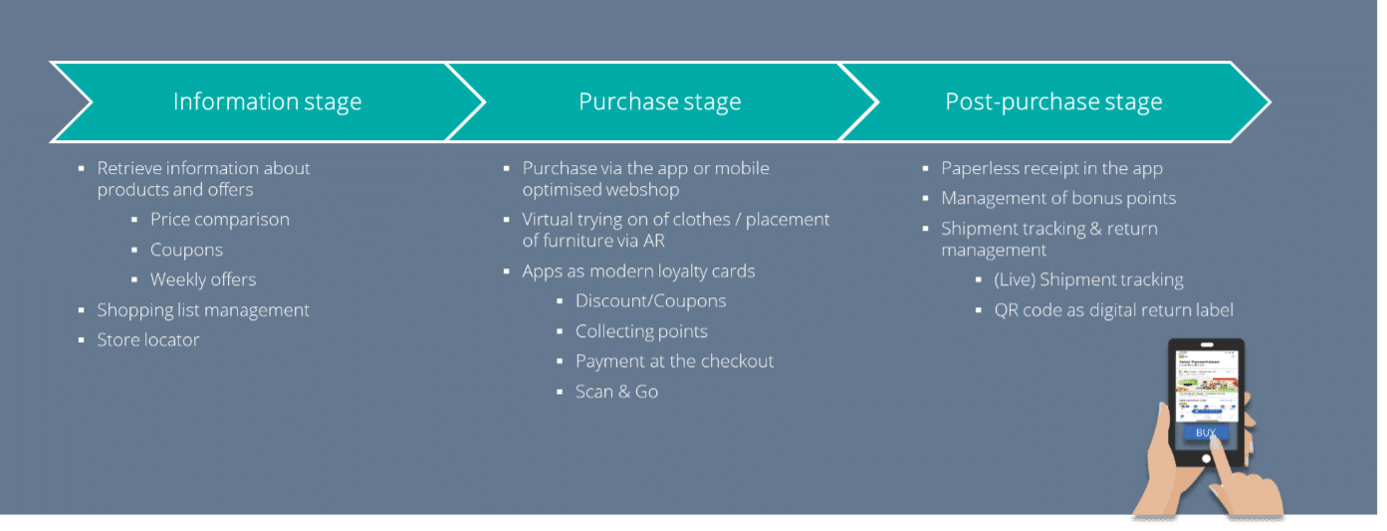Today, more than 4 billion mobile internet users are counted worldwide (Global Digital Report 2020). The continuously increasing smartphone use has an enormous impact on trade and its turnover. According to the forecast, it is expected that in 2021 around 70 percent of global e-commerce turnover will be generated via mobile devices (Statista). In Germany, too, the share of smartphones and tablets in e-commerce was already 49 percent in 2019, whereas the share of shopping via desktop is steadily decreasing. In China, mobile commerce is already so common that online = mobile.
- The user experience is seen as a critical success factor to increase the intention to use mobile apps and prevail in the oversupply of apps.
- Intuitive use as well as creative and experiential design increase the emotional bonding to the application.
- Mobile applications that link stationary and digital commerce can enhance both the shopping experience and customer loyalty.
The rapid development is associated with a great challenge for many companies. This is because they often require completely new, digital and mobile way of thinking about the previous business model. A few years ago, the challenge of commerce was still called e-commerce. The main challenge was to digitalize analogue sales channels and processes. Many companies are still lagging behind this trend today or are still at the beginning of the digitalization of their sales strategies. And now another pressure for change called mobile commerce is turning retail upside down? This shows how fast our society and economy is changing and the pressure companies are under. It is important to follow the individually right digital trends and to meet the needs of customers in order to retain their loyalty in the long term.
But what exactly does mobile commerce mean?
Mobile commerce is a part of e-commerce and refers to all forms of electronic commerce using mobile devices. In particular, the use of mobile applications (apps), also called app commerce, has risen rapidly in recent years. More than a quarter of all e-commerce transactions in Europe are now generated via apps (Criteo, 2018, S. 6).
The use of mobile devices takes place throughout the entire purchasing process. This starts in the information phase and continues through the ordering process to the post-purchase phase. They are thus not only considered a shopping tool for digital retail, but also play an important role in bringing people into the stationary shop.
Today, apps are already used, for example, to find out about offers and products before a purchase, to manage shopping lists or to find the nearest stationary shop in the vicinity. In the purchase phase, the smartphone supports online shopping, virtual trying-on or directly at the point of sale as a mobile customer card for collecting and redeeming bonus points. During the checkout, apps are used as a means of payment – even without a classic checkout in checkout mode (Scan & Go). Location-based push messages or app messages based on the live location can also be used to provide customers with information about offers in real time and create incentives to buy, both inside the shop and in the pedestrian zone, for example.
In the post-purchase phase, billing overviews in the app replace the receipt; users can manage bonus points and track shipments and returns.
And yet we are still at the beginning of mobile commerce. One thing is certain: In the next few years, new mobile business models will continuously develop, especially due to the strong growth in online consumption caused by the pandemic. These will support companies in increasing their sales and customer loyalty and at the same time offer customers added value.
Mobile First, Mobile Only, Smartphone App or mobile-optimised website/online shop – which strategy is the best?
If a company does not have a digital sales channel yet and wants to start directly in mobile commerce, the question arises as to the appropriate strategy. Of course, there is no general answer to this. Rather, the choice of strategy depends on what is to be achieved with a mobile application and how the previous business model is structured.
Yet “mobile first” or “mobile only” are already common buzzwords in many industries. The mobile-first strategy is becoming increasingly popular. Here, the application optimised for mobile devices is created first, followed by step-by-step extensions for the desktop browser. T The core idea of this strategy is to focus on the essential elements at the beginning. In doing so, no more effort and costs are invested than necessary by dispensing with information and operating elements that are unimportant anyway.
The mobile-only strategy means that a company only builds mobile applications. This approach is particularly common in industries where customers make purchases almost exclusively via a mobile app, such as in the mobility sector of bus and train companies. But this strategy is also becoming increasingly important in the retail sector in the form of customer loyalty applications and shopping apps.
If, on the other hand, a web presence already exists, for example in the form of an online shop for the desktop, a choice can be made between an app or a mobile-optimised online shop when embarking on a mobile sales strategy. A native app must be specially designed and developed for each operating system. This is associated with high costs. Attractive alternatives are operating system-independent apps such as web apps, hybrid apps or progressive web apps (PWA). The latter in particular are expected to have great potential in the future. PWAs are seen as a combination of mobile websites and native apps and deliver functions like a native app at a lower cost. The use of push messages, offline capability as well as the anchoring of the app on the screen are possible without downloading from the app store.
There is also the option of setting up a mobile-optimised web shop. These are also independent of the operating system and are a cheaper alternative to apps. However, access to the device hardware, such as camera, microphone or GPS, is limited.
Most important basis: the business model must be put to the test without any ifs and buts
In addition to the concrete and technical implementation, it is advisable to think “mobile” in a completely new way and independently of the previous business model. Otherwise, there is a danger of working too desktop-oriented. In the mobile world, however, different customer needs and expectations prevail with regard to the user experience. One of the most important aspects is the usability and design due to the smaller screen. Today, only a responsive design is no longer sufficient to bind customers to mobile applications in the long term and sustainably and to hold one’s own against the numerous competitors.
For a successful implementation, it is therefore necessary to consider some special requirements:
- The use of micro-interactions, such as the smart placement of call-to-actions or the use of playful elements, is a key factor in the success of a project
- User-friendly operation through structured and comprehensible menu navigation
- Speed and performance through short page loading times
- Creative design to give customers a positive experience and build loyalty
Due to the device-user mapping of a smartphone, personalisation is also becoming more important to create an individual and attractive shopping experience for customers in the digital world. These are personalised user interfaces based on information about app usage as well as preferences through questionnaires. Studies have shown that the selection of images and tonality of texts, as well as personalised recommendations, for example through geolocation or analysis of shopping behaviour, bring great potential with regard to the intention to use the app (source: Stefanie Arz, Persönlichkeitsbasierte Personalisierung im Mobile Commerce, 2020).
In order to be successful in the real world, it is important to continue to take the situational and real life world into account. This can be realised by using the camera of the mobile device, for example, as a body scan for perfect clothing size selection, for the application of augmented reality in all conceivable facets, as well as localisation through GPS or mobile internet.
What are the advantages of entering mobile commerce?
Mobile commerce has become the driving factor for omni-channel commerce. An app can link stationary and digital commerce and enables business models such as “web-to-store” and “web-in-store”, among others.
- We talk about web-to-store when the customer is lured into the stationary shop via an online channel because, for example, the availability of offers and products can be checked live. The availability query can then be extended by an online reservation (Check & Reserve) or purchase component (Click & Collect).
- Web in store includes technologies in stationary retail that make shopping easier for customers. For example, customers can scan QR codes on products and then receive additional information on products by being forwarded to the (shopping) app. By locating smartphones in front of and inside the shop, location-specific advertising messages can be displayed or the customer can be navigated in the store.
Amazon is going one step further with supermarkets without checkouts. Here, the customer registers with the app at the shop entrance and the products in the shopping trolley are automatically settled via the app. However, in addition to a mobile application, numerous sensors and cameras are necessary to realise this business model.
Conclusion
For commerce, the increasing use of smartphones can create great opportunities. In order not to lose customers to competitors and to retain them in the long term, it is important for companies to analyse their business model for potential mobile business models and to enter the world of mobile commerce.
Contact person: Maren Stephan, info@mgm-cp.com
Photo: shutterstock.com / grapestock








